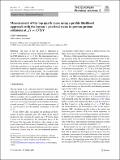Measurement of the top quark mass using a profile likelihood approach with the lepton + jets final states in proton–proton collisions at $$\sqrt{s}=13\,\text {Te}\hspace{-.08em}\text {V} $$ s = 13 Te V
Author(s)
Tumasyan, A.; Adam, W.; Andrejkovic, J. W.; Bergauer, T.; Chatterjee, S.; Damanakis, K.; Dragicevic, M.; Del Valle, A. E.; Hussain, P. S.; Jeitler, M.; Krammer, N.; Lechner, L.; Liko, D.; Mikulec, I.; Paulitsch, P.; Pitters, F. M.; Schieck, J.; Schöfbeck, R.; Schwarz, D.; Sonawane, M.; ... Show more Show less
Download10052_2023_Article_12050.pdf (2.771Mb)
Publisher with Creative Commons License
Publisher with Creative Commons License
Creative Commons Attribution
Terms of use
Metadata
Show full item recordAbstract
The mass of the top quark is measured in 36.3
$$\,\text {fb}^{-1}$$
fb
-
1
of LHC proton–proton collision data collected with the CMS detector at
$$\sqrt{s}=13\,\text {Te}\hspace{-.08em}\text {V} $$
s
=
13
Te
V
. The measurement uses a sample of top quark pair candidate events containing one isolated electron or muon and at least four jets in the final state. For each event, the mass is reconstructed from a kinematic fit of the decay products to a top quark pair hypothesis. A profile likelihood method is applied using up to four observables per event to extract the top quark mass. The top quark mass is measured to be
$$171.77\pm 0.37\,\text {Ge}\hspace{-.08em}\text {V} $$
171.77
±
0.37
Ge
V
. This approach significantly improves the precision over previous measurements.
Date issued
2023-10-25Department
Massachusetts Institute of Technology. Department of PhysicsJournal
The European Physical Journal C
Publisher
Springer Science and Business Media LLC
Citation
The European Physical Journal C. 2023 Oct 25;83(10):963
Version: Final published version
ISSN
1434-6052
Keywords
Physics and Astronomy (miscellaneous), Engineering (miscellaneous)